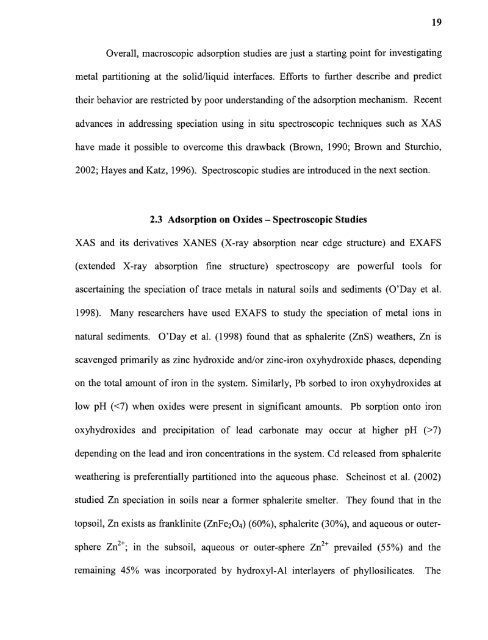Heavy metal adsorption on iron oxide and iron oxide-coated silica ...
Heavy metal adsorption on iron oxide and iron oxide-coated silica ...
Heavy metal adsorption on iron oxide and iron oxide-coated silica ...
Create successful ePaper yourself
Turn your PDF publications into a flip-book with our unique Google optimized e-Paper software.
19Overall, macroscopic <str<strong>on</strong>g>adsorpti<strong>on</strong></str<strong>on</strong>g> studies are just a starting point for investigating<str<strong>on</strong>g>metal</str<strong>on</strong>g> partiti<strong>on</strong>ing at the solid/liquid interfaces. Efforts to further describe <strong>and</strong> predicttheir behavior are restricted by poor underst<strong>and</strong>ing of the <str<strong>on</strong>g>adsorpti<strong>on</strong></str<strong>on</strong>g> mechanism. Recentadvances in addressing speciati<strong>on</strong> using in situ spectroscopic techniques such as XAShave made it possible to overcome this drawback (Brown, 1990; Brown <strong>and</strong> Sturchio,2002; Hayes <strong>and</strong> Katz, 1996). Spectroscopic studies are introduced in the next secti<strong>on</strong>.2.3 Adsorpti<strong>on</strong> <strong>on</strong> Oxides — Spectroscopic StudiesXAS <strong>and</strong> its derivatives XANES (X-ray absorpti<strong>on</strong> near edge structure) <strong>and</strong> EXAFS(extended X-ray absorpti<strong>on</strong> fine structure) spectroscopy are powerful tools forascertaining the speciati<strong>on</strong> of trace <str<strong>on</strong>g>metal</str<strong>on</strong>g>s in natural soils <strong>and</strong> sediments (O'Day et al.1998). Many researchers have used EXAFS to study the speciati<strong>on</strong> of <str<strong>on</strong>g>metal</str<strong>on</strong>g> i<strong>on</strong>s innatural sediments. O'Day et al. (1998) found that as sphalerite (ZnS) weathers, Zn isscavenged primarily as zinc hydr<strong>oxide</strong> <strong>and</strong>/or zinc-ir<strong>on</strong> oxyhydr<strong>oxide</strong> phases, depending<strong>on</strong> the total amount of ir<strong>on</strong> in the system. Similarly, Pb sorbed to ir<strong>on</strong> oxyhydr<strong>oxide</strong>s atlow pH (7)depending <strong>on</strong> the lead <strong>and</strong> ir<strong>on</strong> c<strong>on</strong>centrati<strong>on</strong>s in the system. Cd released from sphaleriteweathering is preferentially partiti<strong>on</strong>ed into the aqueous phase. Scheinost et al. (2002)studied Zn speciati<strong>on</strong> in soils near a former sphalerite smelter. They found that in thetopsoil, Zn exists as franklinite (ZnFe2O4) (60%), sphalerite (30%), <strong>and</strong> aqueous or outersphereZn2+; in the subsoil, aqueous or outer-sphere Zn 2+ prevailed (55%) <strong>and</strong> theremaining 45% was incorporated by hydroxyl-Al interlayers of phyllo<strong>silica</strong>tes. The
















